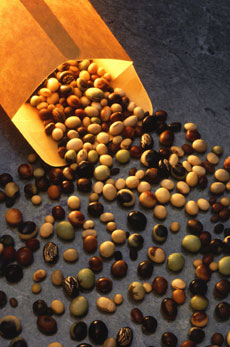 By Maureen Gilmer Scripps Howard News Service April 03, 2005
Despite Victor Boswell's noble words in the 1961 Yearbook of Agriculture, I have suffered many dismal failures with growing from seed. In my maturity I look back upon these difficult seasons and conclude the fault is not always with the seed, but the seedbed.
First, ask yourself: Is the seedbed warm enough? It's a bad idea to hurry spring by putting seeds to bed too early. As temperatures warm outside, the urge to go out and plant is strong. While the air may feel warm and comfortable, the soil still thinks it's winter. Even though the surface may not feel that cold, just an inch deeper temperatures plummet. When you assess your spring soil, check a little deeper down to see if it's still stone-cold or not. What's down there influences temperatures in the shallow seedbed. The year of my worst garden failure, I had simply jumped the gun. Then two things happened. First and most obvious was that seeds that like warm soil to germinate - didn't. Secondly, those that did germinate sent their roots deeper and found super-chilly conditions. They stalled out and immediately became fodder for every slug and bug in the area. In warm soil the seedlings quickly grow beyond the range of most bugs. Have I planted at the right depth? Each seed grows at an optimal depth in the soil. Fortunately, seed packets state this clearly on the label. This isn't a suggestion; it's law. Plant too deeply, and the seedling won't find enough grow power to break the surface. On the other hand, a seed that requires depth for anchorage and protection from moisture evaporation will fail if not planted deeply enough. Shallow seedlings will either dry out or fall over without soil for support. If you are growing seed saved from last year or gathered elsewhere, you won't have a packet to guide you. Try the old-time farmer's rule of thumb: Plant a seed at roughly twice its diameter. While this isn't hard and fast, it helps you find success with most seeds, except those with special needs. Did I wash out the seedbed? Imagine a tiny, feather-light lettuce seed being hit with the gush from a garden hose. There's no way the soil cover or seed will stay in place. Watering washout is a major destroyer of seeds and seedlings. New gardeners can inadvertently cause serious damage with aggressive hose tactics. It's best to buy a nozzle for your hose with a "mist" setting to water these little fellows at the start. Then transition to stronger "rain" setting as they become established. Here are more tips to help you get your seeds up and growing: Know how many days until germination. This is a failure barometer. If it's a week, you'll know you're in trouble if seedlings are not up after 10 days. Press soil over seeds gently. You want them firmly in place, but not too heavily packed. In clay soils it's very easy to over-compact the cover, making it hard for seedlings to pop through. Avoid sowing too densely. Thinning your garden takes time and it disturbs seedlings that are left in the ground. Overly dense planting results in spindly plants that don't bear well and are more subject to pests and diseases. In many states, seed packets are not subject to sales tax because they are considered food, like produce at the grocery store. A system based on agrarian roots does not differentiate between seeds and the end product - edible herbs and vegetables. You can say the beauty of growing from seed is that it binds us to the age-old practitioners of the agrarian arts. But for those pragmatics on a budget, the miracle is a truckload of harvest that's downright cheap, or free.
|
||
